‘Olympia’ Category
» posted on Tuesday, July 10th, 2012 by Linda Lou Burton
Marcus Whitman, Missionary Doctor
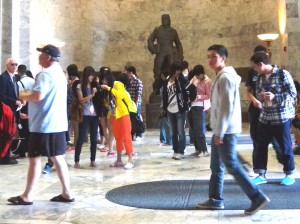 Linda Burton posting from Olympia, Washington – We saw a lot of faces today. Faces of capitol visitors like ourselves, and faces of history, in bronze statues and busts both inside and out, in renderings of the face of George Washington in the shining state seal and on banners furled from balconies, in portraits of former governors hanging on the wall of the Governors Office, and even on the magnificent Tiffany chandelier hanging in the rotunda. But at the end of the day one face and one story in particular stood out. We aimed for an on-the-hour tour – son Rick,
Linda Burton posting from Olympia, Washington – We saw a lot of faces today. Faces of capitol visitors like ourselves, and faces of history, in bronze statues and busts both inside and out, in renderings of the face of George Washington in the shining state seal and on banners furled from balconies, in portraits of former governors hanging on the wall of the Governors Office, and even on the magnificent Tiffany chandelier hanging in the rotunda. But at the end of the day one face and one story in particular stood out. We aimed for an on-the-hour tour – son Rick, 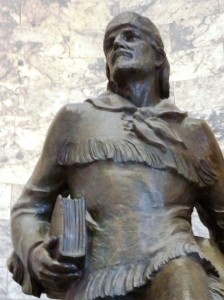 grandkids Andrew and Kayla, and me – and arrived just as a bus-load of Japanese students on a summer study program came in. We began clicking cameras at the same time; the Tour Volunteer manning the front desk stepped up to sort us out for Japanese or English-speaking guides. Above the fray I spotted a hale and hearty looking figure; a statue in bronze who appeared to be looking across the room and beyond. I walked over and read the name inscribed across the bottom: Marcus Whitman. His story is one of good intent, with a tragic ending. Listen. » read more
grandkids Andrew and Kayla, and me – and arrived just as a bus-load of Japanese students on a summer study program came in. We began clicking cameras at the same time; the Tour Volunteer manning the front desk stepped up to sort us out for Japanese or English-speaking guides. Above the fray I spotted a hale and hearty looking figure; a statue in bronze who appeared to be looking across the room and beyond. I walked over and read the name inscribed across the bottom: Marcus Whitman. His story is one of good intent, with a tragic ending. Listen. » read more
» posted on Tuesday, July 10th, 2012 by Linda Lou Burton
Family Cool
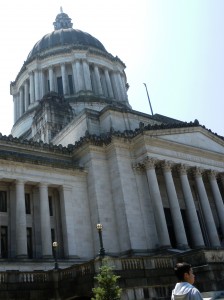 Andrew Shumate, age 16, visiting grandmother in Olympia, Washington – “Come to Olympia while the Journey is there,” GMom said last week, so that’s what we did today, my father, my sister, and me. As we drove up to the capitol the first thing my father and I noticed was how dirty it looked! I mean that building is the center of our state government, where our politicians represent us, where our laws are made, and it looked like someone needed to give it a good hosing down. But I guess that isn’t really important considering the building’s amazing architecture. I visited this capitol ten years ago and didn’t think much
Andrew Shumate, age 16, visiting grandmother in Olympia, Washington – “Come to Olympia while the Journey is there,” GMom said last week, so that’s what we did today, my father, my sister, and me. As we drove up to the capitol the first thing my father and I noticed was how dirty it looked! I mean that building is the center of our state government, where our politicians represent us, where our laws are made, and it looked like someone needed to give it a good hosing down. But I guess that isn’t really important considering the building’s amazing architecture. I visited this capitol ten years ago and didn’t think much 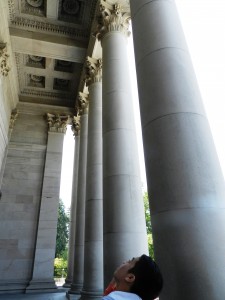 about its design; I just thought it looked like a fancy government building. But this time around I was able to appreciate how amazing it really is, even if it looked somewhat dirty. I noticed the building was heavily influenced by Greek and Roman architecture. The building features a massive dome, which the tour guide later told us is the tallest masonry dome in North America. The entrance is supported by intricate Corinthian columns and the rest of the building is fitted with the not-so-intricate Doric columns. All of which originated from ancient Greek and Roman architecture. Having studied this stuff for several months I just had to inform everyone of my knowledge regarding this subject. » read more
about its design; I just thought it looked like a fancy government building. But this time around I was able to appreciate how amazing it really is, even if it looked somewhat dirty. I noticed the building was heavily influenced by Greek and Roman architecture. The building features a massive dome, which the tour guide later told us is the tallest masonry dome in North America. The entrance is supported by intricate Corinthian columns and the rest of the building is fitted with the not-so-intricate Doric columns. All of which originated from ancient Greek and Roman architecture. Having studied this stuff for several months I just had to inform everyone of my knowledge regarding this subject. » read more
» posted on Monday, July 9th, 2012 by Linda Lou Burton
Bob, On Action
 Linda Burton posting from Olympia, Washington – “This is my park,” said Bob, stooping over to pick up a bit of trash. We are walking in Heritage Park, just downhill from the Washington State Capitol, and Bob has been pointing out the various features of this crowd-pleasing spot by Capitol Lake. “You mean from when you were Mayor?” I asked. “Oh no, way before that,” was his answer. “I started working on this park years ago.” If they put a picture by the words “citizen activist” in the dictionary, it would be a picture of Bob Jacobs. I think his picture would be there twice, in fact, also by the words “live wire.” Bob is energetic, enthusiastic, and concerned. Never one to talk about what “ought” to be done, Bob jumps in to get it done. He believes that good government, and a good
Linda Burton posting from Olympia, Washington – “This is my park,” said Bob, stooping over to pick up a bit of trash. We are walking in Heritage Park, just downhill from the Washington State Capitol, and Bob has been pointing out the various features of this crowd-pleasing spot by Capitol Lake. “You mean from when you were Mayor?” I asked. “Oh no, way before that,” was his answer. “I started working on this park years ago.” If they put a picture by the words “citizen activist” in the dictionary, it would be a picture of Bob Jacobs. I think his picture would be there twice, in fact, also by the words “live wire.” Bob is energetic, enthusiastic, and concerned. Never one to talk about what “ought” to be done, Bob jumps in to get it done. He believes that good government, and a good  community, come about through citizen involvement, and he is one fine example of an involved citizen. Yes, he was Mayor of Olympia, for three terms, back in the 90’s. That tells you something about this man’s interest in his community. And today he’s active on more committees and boards than you can count on two hands, one of them the Board of Capital Cities USA. We are meeting today to talk about the capital city of Olympia, and about how you get things done, whatever the vision. » read more
community, come about through citizen involvement, and he is one fine example of an involved citizen. Yes, he was Mayor of Olympia, for three terms, back in the 90’s. That tells you something about this man’s interest in his community. And today he’s active on more committees and boards than you can count on two hands, one of them the Board of Capital Cities USA. We are meeting today to talk about the capital city of Olympia, and about how you get things done, whatever the vision. » read more
» posted on Sunday, July 8th, 2012 by Linda Lou Burton
How Nice, Olympia
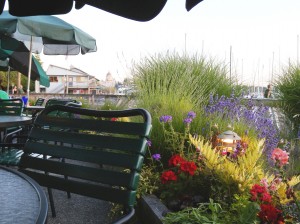 Linda Burton posting from Olympia, Washington – The children at the next table were squirmy bored. Mom offered crayon enticements to no avail; Dad kept eating. The little girl wiggled out of her chair, slid backwards, and wound up by the flower bed. “Look, Mommy,” she said. “Pretty.” She leaned over the fragrant lavender and pulled it to her face. “Nice,” she smiled. I had to agree with the little girl. It was nice, outdoors on the patio of this restaurant-by-the-water; the warmth of the late-afternoon sun; the scent of lavender. Red geraniums and ornamental grasses filled my view to the right; the boardwalk stretched my gaze a mile towards town. I could see the dome of the capitol above the masts of sailboats moored on water that was smooth as glass. The little boy joined his sister; they sat together on the planter’s wooden edge and talked the talk that children talk when all is well. After a bit the family headed down the boardwalk, holding hands. How nice, Olympia. This seems to be a magic place. » read more
Linda Burton posting from Olympia, Washington – The children at the next table were squirmy bored. Mom offered crayon enticements to no avail; Dad kept eating. The little girl wiggled out of her chair, slid backwards, and wound up by the flower bed. “Look, Mommy,” she said. “Pretty.” She leaned over the fragrant lavender and pulled it to her face. “Nice,” she smiled. I had to agree with the little girl. It was nice, outdoors on the patio of this restaurant-by-the-water; the warmth of the late-afternoon sun; the scent of lavender. Red geraniums and ornamental grasses filled my view to the right; the boardwalk stretched my gaze a mile towards town. I could see the dome of the capitol above the masts of sailboats moored on water that was smooth as glass. The little boy joined his sister; they sat together on the planter’s wooden edge and talked the talk that children talk when all is well. After a bit the family headed down the boardwalk, holding hands. How nice, Olympia. This seems to be a magic place. » read more
» posted on Saturday, July 7th, 2012 by Linda Lou Burton
Windows in Time
 Linda Burton posting from Olympia, Washington – “You should get together with that blond lady that’s staying here,” Mae told me as she took my ticket and greeted me in the breakfast room every morning. “She knows everything about the history of Olympia. You two should talk.” But we kept missing each other, until finally the planets aligned and we wound up having breakfast at the same time. “You must be the person writing about capital cities,” she said, standing beside my table with a cup of coffee in hand. “And you must be the blond lady that knows everything about Olympia,” I replied. “Please sit down.” The “blond lady” I’d finally met is Susan Parish, and the ensuing conversation led me to believe she not only knows the history of Olympia,
Linda Burton posting from Olympia, Washington – “You should get together with that blond lady that’s staying here,” Mae told me as she took my ticket and greeted me in the breakfast room every morning. “She knows everything about the history of Olympia. You two should talk.” But we kept missing each other, until finally the planets aligned and we wound up having breakfast at the same time. “You must be the person writing about capital cities,” she said, standing beside my table with a cup of coffee in hand. “And you must be the blond lady that knows everything about Olympia,” I replied. “Please sit down.” The “blond lady” I’d finally met is Susan Parish, and the ensuing conversation led me to believe she not only knows the history of Olympia,  she has a photograph of most of it. She’s staying at the Governor Hotel now because she’s commissioned to “recreate the history of the hotel” through researching the art and times of the hotel’s early days, now being remodeled to capture the look of its beginnings, the 1970’s. As we walked through the newly renovated rooms on the upper floors, Susan showed me the photographs she is installing, and told me more of her work. » read more
she has a photograph of most of it. She’s staying at the Governor Hotel now because she’s commissioned to “recreate the history of the hotel” through researching the art and times of the hotel’s early days, now being remodeled to capture the look of its beginnings, the 1970’s. As we walked through the newly renovated rooms on the upper floors, Susan showed me the photographs she is installing, and told me more of her work. » read more
» posted on Wednesday, July 4th, 2012 by Linda Lou Burton
Of Thee I Sing
 Linda Burton posting from Olympia, Washington – “My country ‘tis of thee, sweet land of liberty, of thee I sing. Land where my fathers died, land of the Pilgrims’ pride, from every mountain side, let freedom ring” (Samuel Francis Smith, author, 1831). It may be Francis Scott Key’s Star Spangled Banner that gets us standing and saluting at baseball games, but nobody can deny that Samuel Francis Smith’s America is a more user-friendly tune. Who can hit that ultra-high Anthem note right there at the end? It has challenged (and embarrassed) a number of high-voltage music stars, and puzzled many a kid who hasn’t studied US history yet. Bombs bursting in air? Does that mean fireworks Dad? It’s the 4th of July today; a federally recognized holiday; and many celebrations do include fireworks – Washington DC with the national capitol in the background; the Navy Pier on Lake Michigan in Chicago; Macy’s in New York; San Diego, Seattle, Tampa; big city blasts and small town set offs; or maybe just a back yard barbecue with a few illegal poppers to make noise and sparklers for the kids to wave around. Maybe the family has started vacation already, celebrating in a National Park; fanfare and awesomeness. It was quiet today in Olympia, and I went exploring to get pictures of the American flag. » read more
Linda Burton posting from Olympia, Washington – “My country ‘tis of thee, sweet land of liberty, of thee I sing. Land where my fathers died, land of the Pilgrims’ pride, from every mountain side, let freedom ring” (Samuel Francis Smith, author, 1831). It may be Francis Scott Key’s Star Spangled Banner that gets us standing and saluting at baseball games, but nobody can deny that Samuel Francis Smith’s America is a more user-friendly tune. Who can hit that ultra-high Anthem note right there at the end? It has challenged (and embarrassed) a number of high-voltage music stars, and puzzled many a kid who hasn’t studied US history yet. Bombs bursting in air? Does that mean fireworks Dad? It’s the 4th of July today; a federally recognized holiday; and many celebrations do include fireworks – Washington DC with the national capitol in the background; the Navy Pier on Lake Michigan in Chicago; Macy’s in New York; San Diego, Seattle, Tampa; big city blasts and small town set offs; or maybe just a back yard barbecue with a few illegal poppers to make noise and sparklers for the kids to wave around. Maybe the family has started vacation already, celebrating in a National Park; fanfare and awesomeness. It was quiet today in Olympia, and I went exploring to get pictures of the American flag. » read more
» posted on Tuesday, July 3rd, 2012 by Linda Lou Burton
Bonjour, Governor
 Linda Burton posting from Olympia, Washington – Lavender? Chipotle Chocolate? Strawberry Margarita? Cupcakes by the dazzle sit before me arrayed on china plates and perched in baskets on a stand, their names in silver holders, tucked into a glass case framed in walnut, in a room of crystal chandeliers. The sugar-plum fairy has surely been here, lives here, runs the place! I approach in awe, a lavender cupcake? That will be my first choice; I’ve never had flowers-in-cake before. But look at that, chocolate with a pretty swirl on top, Fleur de Sel is what it tells me by its
Linda Burton posting from Olympia, Washington – Lavender? Chipotle Chocolate? Strawberry Margarita? Cupcakes by the dazzle sit before me arrayed on china plates and perched in baskets on a stand, their names in silver holders, tucked into a glass case framed in walnut, in a room of crystal chandeliers. The sugar-plum fairy has surely been here, lives here, runs the place! I approach in awe, a lavender cupcake? That will be my first choice; I’ve never had flowers-in-cake before. But look at that, chocolate with a pretty swirl on top, Fleur de Sel is what it tells me by its  tag. Choice #2, a French delight. “May I help you?” lifts me from my reverie, and I have to say “I’m still thinking,” which I am. I must take three, no, make that four, to fit evenly in the box (and they’re just bite-size, I justify). Red Velvet will be #3; and then I agonize. Toffee? Honey Almond? No, I settle for Key Lime Pie; Key Lime Pie in a cupcake. I call my choices one by one; my treasures are cradled in a pretty box, presented to me with flair. What is this magic shop? » read more
tag. Choice #2, a French delight. “May I help you?” lifts me from my reverie, and I have to say “I’m still thinking,” which I am. I must take three, no, make that four, to fit evenly in the box (and they’re just bite-size, I justify). Red Velvet will be #3; and then I agonize. Toffee? Honey Almond? No, I settle for Key Lime Pie; Key Lime Pie in a cupcake. I call my choices one by one; my treasures are cradled in a pretty box, presented to me with flair. What is this magic shop? » read more
» posted on Monday, July 2nd, 2012 by Linda Lou Burton
All-America City
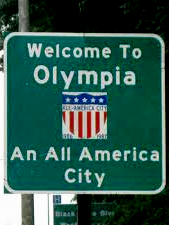 Linda Burton posting from Olympia, Washington – Birds singing outside the window are always a good sign. A breakfast ticket, an elevator ride, a warm greeting at the front desk as I pick up the morning paper. In the breakfast room I lay my paper on a table by the window and head for the buffet, scrambled eggs and sausages, fruit and yogurt; over on the bar the toasters and the bagels sit, ah, I see, this was once a dining room in the hotel, now serving breakfast just for guests. Coffee, orange juice, I think I’m set. It’s time to eat, and read the paper, what better way to start the day? The paper is the Olympian, a fitting name. City traffic moves on Capitol, across the street in Sylvester Park a backpacker stretches on a bench. The newspaper tells of plans for celebrating the 4th in the communities around; family festivals, fireworks, parades with a four-legged fourth (Otis the police dog will be Grand Marshall), a Volkssport walk. And the All-America City awards are announced; fourteen new cities are named. Olympia, Washington received that honor some years back, I remember; that’s right, I’m having breakfast in an All-America City! » read more
Linda Burton posting from Olympia, Washington – Birds singing outside the window are always a good sign. A breakfast ticket, an elevator ride, a warm greeting at the front desk as I pick up the morning paper. In the breakfast room I lay my paper on a table by the window and head for the buffet, scrambled eggs and sausages, fruit and yogurt; over on the bar the toasters and the bagels sit, ah, I see, this was once a dining room in the hotel, now serving breakfast just for guests. Coffee, orange juice, I think I’m set. It’s time to eat, and read the paper, what better way to start the day? The paper is the Olympian, a fitting name. City traffic moves on Capitol, across the street in Sylvester Park a backpacker stretches on a bench. The newspaper tells of plans for celebrating the 4th in the communities around; family festivals, fireworks, parades with a four-legged fourth (Otis the police dog will be Grand Marshall), a Volkssport walk. And the All-America City awards are announced; fourteen new cities are named. Olympia, Washington received that honor some years back, I remember; that’s right, I’m having breakfast in an All-America City! » read more
» posted on Sunday, July 1st, 2012 by Linda Lou Burton
Sunday Morning Coming Down
 Linda Burton posting from Olympia, Washington – The joke is “summer doesn’t arrive in the Pacific Northwest until after the 4th of July” but it’s no joke. In 1987 I dried out in front of a blazing fire after giving up on the soggy Seattle fireworks display and coming home sopping wet and shivering. It looks as though this year will follow that pattern; it was raining when I woke up; a Sunday morning gray. A cat snuggled tight against either side of me; I guess I’m forgiven for taking off for Hawaii and leaving them behind. I opened up the Fancy Feast and then slept two hours more. Under the blanket and the pile of cats it was cozy and warm, but checkout time loomed close; time to load the car, drive to Olympia, unload everything, settle in for the next two-week stint. I was misty-soaked and feeling blue in all the gray, my body temp still set on Hawaiian warm. Just drive, I told myself. » read more
Linda Burton posting from Olympia, Washington – The joke is “summer doesn’t arrive in the Pacific Northwest until after the 4th of July” but it’s no joke. In 1987 I dried out in front of a blazing fire after giving up on the soggy Seattle fireworks display and coming home sopping wet and shivering. It looks as though this year will follow that pattern; it was raining when I woke up; a Sunday morning gray. A cat snuggled tight against either side of me; I guess I’m forgiven for taking off for Hawaii and leaving them behind. I opened up the Fancy Feast and then slept two hours more. Under the blanket and the pile of cats it was cozy and warm, but checkout time loomed close; time to load the car, drive to Olympia, unload everything, settle in for the next two-week stint. I was misty-soaked and feeling blue in all the gray, my body temp still set on Hawaiian warm. Just drive, I told myself. » read more
